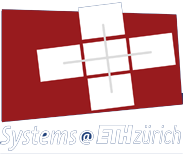Publication
Proceedings of the 23rd International Conference on Architectural Support for Programming Languages and Operating Systems (ASPLOS), Williamsburg, VA, USA, March 2018
Emerging chips with hundreds and thousands of cores require networks with unprecedented energy/area efficiency and scalability. To address this, we propose Slim NoC (SN): a new on-chip network design that delivers significant improvements in efficiency and scalability compared to the state-of-the-art. The key idea is to use two concepts from graph and number theory, degree-diameter graphs combined with non-prime finite fields, to enable the smallest number of ports for a given core count. SN is inspired by state-of-the-art off-chip topologies; it identifies and distills their advantages for NoC settings while solving several key issues that lead to significant overheads on-chip. SN provides NoC-specific layouts, which further enhance area/energy efficiency. We show how to augment SN with state-of-the-art router microarchitecture schemes such as Elastic Links, to make the network even more scalable and efficient. Our extensive experimental evaluations show that SN outperforms both traditional low-radix topologies (e.g., meshes and tori) and modern high-radix networks (e.g., various Flattened Butterflies) in area, latency, throughput, and static/dynamic power consumption for both synthetic and real workloads. SN provides a promising direction in scalable and energy-efficient NoC topologies.
@inproceedings{abc,
abstract = {Emerging chips with hundreds and thousands of cores require networks with unprecedented energy/area efficiency and scalability. To address this, we propose Slim NoC (SN): a new on-chip network design that delivers significant improvements in efficiency and scalability compared to the state-of-the-art. The key idea is to use two concepts from graph and number theory, degree-diameter graphs combined with non-prime finite fields, to enable the smallest number of ports for a given core count. SN is inspired by state-of-the-art off-chip topologies; it identifies and distills their advantages for NoC settings while solving several key issues that lead to significant overheads on-chip. SN provides NoC-specific layouts, which further enhance area/energy efficiency. We show how to augment SN with state-of-the-art router microarchitecture schemes such as Elastic Links, to make the network even more scalable and efficient. Our extensive experimental evaluations show that SN outperforms both traditional low-radix topologies (e.g., meshes and tori) and modern high-radix networks (e.g., various Flattened Butterflies) in area, latency, throughput, and static/dynamic power consumption for both synthetic and real workloads. SN provides a promising direction in scalable and energy-efficient NoC topologies.},
author = {Maciej Besta and Syed M. Hassan and Sudhakar Yalamanchili and Rachata Ausavarungnirun and Onur Mutlu and Torsten Hoefler},
booktitle = {Proceedings of the 23rd International Conference on Architectural Support for Programming Languages and Operating Systems (ASPLOS)},
title = {Slim NoC: A Low-Diameter On-Chip Network Topology for High Energy Efficiency and Scalability},
venue = {Williamsburg, VA, USA},
year = {2018}
}

